Massive snow accumulation on a roof creates the potential for an unpredictable avalanche-like effect. Metal is a great choice for your rooftop. It has a long life expectancy and can stand up to the harshest conditions. It does have a low coefficient of friction though–meaning things (including snow) don’t stick to it very well. But the notion that snow is intended to slide off a metal roof is misguided and can be dangerous.
Won’t I Damage My Roof if I Attach Snow Guards to it?
|
Even the best snow guard system can cause damage if it is not properly engineered to the project. That is why any system must be prudently tested, engineered and time-proven. A properly engineered snow guard system takes into account:
|
Example of ineffective glued-on snow guards. Danger is potentially averted by strategic cart placement. But is this really a viable solution? |
How Do I Know How Much Snow My Roof Can Handle?
“Design snow load” is the downward force for which a building's roof is designed (the weight of accumulated snow and ice it can handle). Access this information from your building contractor, project engineer or in the structural plans for the building. “Allowable capacity” is the tested failure load divided by a factor of safety to ensure the product cannot fail in service.
Don’t expose yourself to liability or leave your customers unprotected. Install snow guards!
Ice sheets falling in Plano, Texas
Seeking a technical guide for engineering-based snow guard design?
______________________________________________________________________________
Download Qualifying Snow Retention Systems by the Metal Construction Association (MCA).
____________________________________________________________________________
The three main types of snow guards:
- Structure Attachment (Brackets) – Attaches by penetrative, mechanical fastening through the roof and into the building’s structural components (typically purlins or trusses).
- Clamp-Mounted (Clamps) – Uses a metal roof seam to fasten a clamp onto - with round-point setscrews that apply pressure onto the seam but do not puncture the metal.
- Adhesive/Stick-On (Glued-On/”Peel and Stick”) – Attaches (chemically) proprietary variations of cleats to the roof surface.
 |
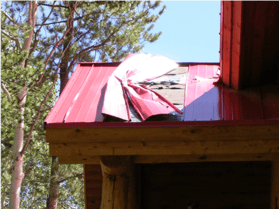 |
| Roof damage from a rooftop avalanche - no snow guards in use | Lower roof damage from a rooftop avalanche - no snow guards in use |
The above are then either unitized (dis-continuous) or continuous. Unitized snow guards (snow cleats, pad-style snow guards) can be single- or multi-component and do not require a continuous cross-member (a bar or pipe that forms a connection to all the pieces). Normally used in a redundant manner, unitized snow guards rely on snowpack “bridging” between adjacent devices. They often attach via adhesives.
Continuous snow guards (rail-type, snow fence, snow rail, pipe-style snow guards) use brackets or clamps and cross-members anchored to them to prevent sliding snow. Continuous snow guards can be made up of one or multiple cross-members.
The Pros and Cons
Structure AttachmentPros
|
Example of a waterproofing failure in a mechanically-attached (non-penetrating) snow guard system |
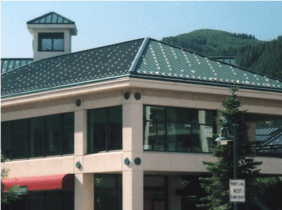
Snow guards that appear “invisible” are highly reflective when actually installed on a roof. |
Cons
|
Clamp-Mounted
Pros
- Does not require drilling holes in roof that could leak – no waterproofing required
- Will not fatigue due to thermal heating or cooling of roof
- Can be mounted after roof has been installed
- Uses setscrews that won’t damage the metal
- Non-penetrating clamps won’t void roof manufacturer’s warranty
Cons
- Sliding force of snow is transferred to clamp and to roof panels – must know holding strength of the system. Few systems on the market have been adequately tested for this.
- Damage to roof if testing/engineering protocols not observed
- Can only be used on standing seam type roof profiles
Adhesive (Glued-On)Pros
|
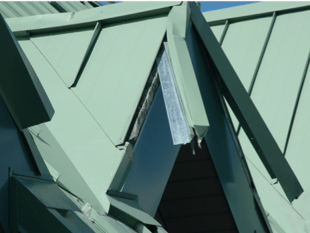
Roof damage caused by avalanching snow - no snow guards in use |
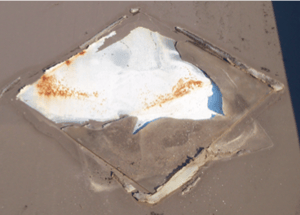
The holding strength of stick-on snow guards diminishes with age and as the adhesive degrades. Once the bond fails, the guard can rip away paint from the roof panel. |
Cons
|
So, Will Snow Guards Damage Your Roof?They sure can! But only if you don’t take the above precautions into consideration. If not properly engineered, the weight of the snow can be too much for a single piece when glued onto the roof – or even when mechanically-attached. |
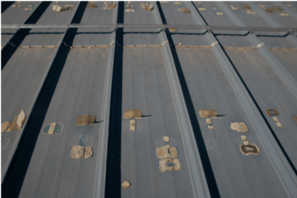
Failed plastic snow guards on a metal roof - premature fading and premature adhesive failure due to UV exposure |
In all instances, mechanically-attached snow guard systems are the best method for a variety of roof types and snow loads because their holding strength is not diminished with time. But only when properly tested, engineered and installed, will these products work as intended without causing harm to the roof. This is the most proven and effective way to prevent rooftop avalanches.
What Can You Do to Avoid Damage to Your Metal Roof?
- Verify that your specific roof profile has been tested with the specific system you want to install.
- Ask for written proof of this testing on the actual profile and substrate by an accredited lab.
- You should also ask to see the engineered calculations.
- Don’t be tempted to just accept any sales hype thrown at you to cover up for a lack of facts or real testing.
- Ask for the proof!
Need help deciding on the right snow guard system for your metal roof? Learn more about the only snow guard system good enough to be warranted for the life of the roof. All of our systems are rigorously tested and time-proven. Test results are displayed at our website and engineering tools are also available there to design any system for any metal roof.

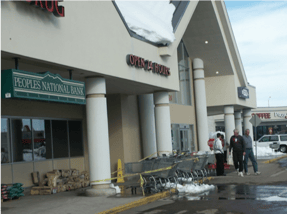

%20snow%20guard%20system.png?width=317&name=Example%20of%20a%20waterproofing%20failure%20in%20a%20mechanically-attached%20(non-penetrating)%20snow%20guard%20system.png)